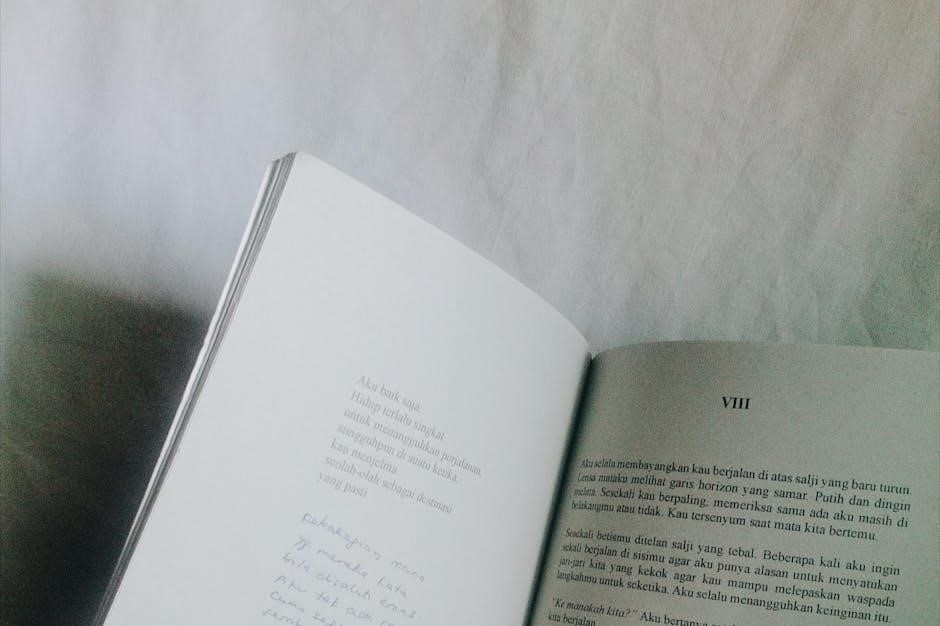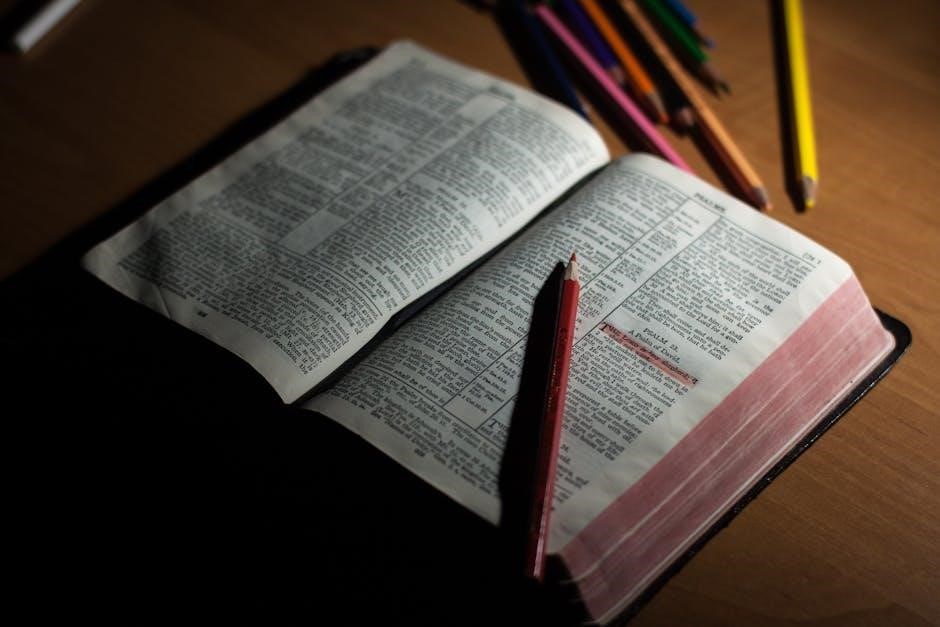“Sadako and the Thousand Paper Cranes” tells the true story of Sadako Sasaki‚ a young girl affected by the Hiroshima bombing‚ showcasing her courage and hope through origami‚ symbolizing peace and humanity.
1.1 Overview of the Book
“Sadako and the Thousand Paper Cranes” by Eleanor Coerr is a poignant children’s book based on the true story of Sadako Sasaki‚ a young girl affected by the Hiroshima bombing. The story follows her journey as she battles leukemia‚ folding paper cranes to fulfill a legend promising a wish upon completing a thousand. It highlights her resilience‚ hope‚ and the cultural significance of paper cranes in Japan‚ becoming a powerful symbol of peace and humanity. The book is both emotionally moving and educational‚ inspiring global peace movements.
1.2 The True Story Behind the Book
Sadako and the Thousand Paper Cranes is based on the real-life story of Sadako Sasaki‚ a young girl who lived in Hiroshima from 1943 to 1955. She was exposed to the atomic bomb’s radiation at age two‚ developing leukemia years later. Inspired by a Japanese legend‚ Sadako folded paper cranes‚ believing that completing a thousand would grant her wish to recover. Her story‚ though tragic‚ became a global symbol of hope‚ peace‚ and the human cost of war.
1.3 The Author: Eleanor Coerr
Eleanor Coerr‚ an American author‚ wrote “Sadako and the Thousand Paper Cranes” to share Sadako Sasaki’s inspiring story. Coerr was moved by Sadako’s courage and the symbolic power of her paper cranes. The book‚ based on real events‚ highlights themes of hope‚ resilience‚ and peace. Coerr’s storytelling has made the book a beloved and educational resource‚ introducing readers worldwide to Sadako’s legacy and the importance of promoting peace through her story.

Historical Context of Hiroshima and the Atomic Bombing
The atomic bombing of Hiroshima in 1945 caused unprecedented destruction‚ leading to thousands of deaths and long-term suffering‚ including leukemia cases like Sadako Sasaki’s.
2.1 The Impact of the Atomic Bomb on Hiroshima
The atomic bombing of Hiroshima on August 6‚ 1945‚ caused catastrophic destruction‚ killing thousands instantly and leaving many more with severe injuries. The blast and subsequent radiation exposure led to long-term health issues‚ including leukemia‚ which affected Sadako Sasaki. The bombing devastated the city‚ destroying infrastructure and displacing survivors. It also left a lasting emotional and psychological impact on the people of Hiroshima‚ shaping their lives and inspiring global peace movements. The event remains a powerful symbol of the horrors of war and the importance of nuclear disarmament.
2.2 Sadako Sasaki: A Victim of the Bombing
Sadako Sasaki was a young girl who survived the Hiroshima bombing at age two but later developed leukemia from radiation exposure. Her story became a symbol of the bombing’s tragic consequences. Sadako’s courage and resilience inspired those around her as she folded paper cranes‚ believing the legend that a thousand cranes could grant a wish. Her journey represents the human cost of war and the enduring hope for peace‚ leaving a lasting legacy in the hearts of people worldwide.
2.3 The Legacy of the Bombing in Modern Times
The Hiroshima bombing’s legacy endures as a poignant reminder of war’s devastation. Today‚ Sadako’s story and the paper cranes symbolize global peace efforts. Annual tributes honor her memory‚ inspiring anti-nuclear movements. The book highlights her courage‚ ensuring future generations remember the bombing’s impact. Sadako’s legacy continues to advocate for peace and humanity‚ serving as a powerful reminder of the importance of nuclear disarmament and the enduring hope for a peaceful world.

The Legend of the Thousand Paper Cranes
The legend promises that folding a thousand paper cranes grants a wish. Sadako‚ inspired by this tradition‚ folded cranes to wish for recovery‚ symbolizing hope and resilience.
3.1 The Origins of the Legend
The legend of the thousand paper cranes originates from Japanese folklore‚ where cranes symbolize longevity and good fortune. The belief is that folding a thousand cranes grants a wish. This tradition‚ deeply rooted in Japanese culture‚ inspired Sadako Sasaki‚ who folded cranes while battling leukemia caused by the Hiroshima bombing. Her story popularized the legend globally‚ linking it to hope‚ resilience‚ and peace. The crane became a powerful symbol of healing and humanity‚ transcending its origins in traditional Japanese beliefs.
3.2 The Symbolism of the Paper Crane in Japanese Culture
In Japanese culture‚ the paper crane is a revered symbol of longevity‚ good fortune‚ and peace. According to folklore‚ cranes live for a thousand years‚ making them a representation of eternal life. The art of folding paper cranes‚ known as origami‚ is deeply rooted in tradition and often performed during celebrations like New Year. The crane’s elegance and grace have made it a popular motif in art‚ literature‚ and ceremonies‚ embodying hope and healing. Sadako’s story further cemented its significance as a universal symbol of peace and resilience.
3.3 Sadako’s Wish and the Thousand Cranes
Sadako believed in the legend that folding a thousand paper cranes would grant her wish. Diagnosed with leukemia from the atomic bomb‚ she hoped to recover and live a healthy life. Her determination to fold the cranes symbolized her resilience and faith in the power of hope. Though she passed away before completing them‚ her story inspired others to continue her legacy‚ turning her into a global symbol of peace and the enduring human spirit.

The Book’s Themes and Messages
Hope‚ resilience‚ peace‚ and cultural heritage are central themes‚ emphasizing the power of hope in tragedy‚ the importance of nonviolence‚ and the value of preserving traditions.
4.1 Hope and Resilience in the Face of Tragedy
Sadako’s story embodies hope and resilience as she faces leukemia with determination. Folding paper cranes becomes her symbol of hope for recovery and peace. The legend of 1‚000 cranes represents longevity and good fortune‚ inspiring her to persevere. Her courage in the face of illness and tragedy highlights the strength of the human spirit‚ leaving a lasting legacy of hope and peace for future generations.
4.2 The Power of Peace and Nonviolence
Sadako’s story underscores the power of peace and nonviolence. Her determination to fold 1‚000 paper cranes symbolizes a universal plea for peace‚ transcending borders and generations. The book highlights how her courage and resilience inspired global anti-nuclear movements‚ advocating for a world free from war. Through her legacy‚ Sadako became a symbol of peace‚ reminding humanity of the importance of nonviolence and the need to strive for a harmonious world.
4.3 The Importance of Cultural Heritage
Sadako and the Thousand Paper Cranes emphasizes the significance of cultural heritage through the traditional Japanese art of origami. The story highlights the legend of the 1‚000 paper cranes‚ a symbol deeply rooted in Japanese culture‚ representing longevity and good fortune. By sharing this tradition‚ the book preserves and celebrates Japan’s cultural legacy‚ inspiring readers to appreciate and honor their own heritage. Sadako’s journey not only reflects personal resilience but also the enduring value of cultural traditions in shaping identity and hope.

The Story’s Global Impact
Sadako and the Thousand Paper Cranes has inspired millions worldwide‚ promoting peace and unity. Its message transcends borders‚ making it a universal symbol of hope and humanity.
5.1 The Book’s Popularity Worldwide
Sadako and the Thousand Paper Cranes has gained global recognition for its poignant narrative. Translated into multiple languages‚ it resonates with readers worldwide‚ inspiring empathy and peace advocacy. The story’s universal themes of hope and resilience have made it a beloved read in schools and homes globally. Its availability as a PDF has further expanded its reach‚ ensuring Sadako’s legacy continues to inspire future generations to strive for a peaceful world.
5.2 Educational Significance in Schools
Sadako and the Thousand Paper Cranes is widely used in schools to teach students about the consequences of war and the importance of peace. The story’s simplicity and emotional depth make it accessible to young readers‚ fostering empathy and understanding. Educators often incorporate the book into history and literature curricula‚ using it to discuss global conflicts and cultural traditions. Its themes of resilience and hope inspire meaningful classroom discussions and reflections on humanity’s shared desire for peace.
5.3 The Book’s Role in Promoting Peace Education
Sadako and the Thousand Paper Cranes plays a vital role in peace education by sharing a powerful story of hope and resilience. The book inspires discussions about the consequences of war and the importance of nonviolence. Its universal message encourages students to reflect on peace and humanity‚ making it a valuable resource for educators. The story of Sadako and her paper cranes has become a global symbol of peace‚ fostering empathy and promoting a commitment to a peaceful world.

The Cultural Significance of Paper Cranes
Paper cranes hold deep cultural significance in Japan‚ symbolizing peace‚ longevity‚ and good fortune. The tradition of folding thousand paper cranes embodies hope and resilience‚ inspiring global unity.
6.1 The Art of Origami and Its History
Origami‚ the art of paper folding‚ has ancient roots in Japan‚ traditionally used in ceremonies and storytelling. The word combines “ori” (folded) and “kami” (paper). Modern origami evolved in the 20th century‚ becoming a global art form. The paper crane‚ or senbazuru‚ symbolizes peace and longevity. Folding a thousand cranes‚ a traditional prayer for health and happiness‚ became a powerful symbol of hope through Sadako’s story‚ embedding origami into a global movement for peace and nuclear disarmament.
6.2 Paper Cranes as a Symbol of Longevity and Good Fortune
In Japanese culture‚ the crane is a revered symbol of longevity and good fortune‚ believed to live for a thousand years. The tradition of folding a thousand paper cranes‚ known as senbazuru‚ is rooted in this symbolism‚ representing a prayer for health‚ happiness‚ and longevity. Sadako’s story transformed this tradition into a global emblem of peace‚ connecting the crane’s timeless significance to humanity’s hope for a harmonious world.
6.3 The Connection Between Paper Cranes and Sadako’s Legacy
Sadako’s story deeply intertwined with the paper crane‚ transforming it into a global symbol of peace and hope. Her determination to fold 1‚000 cranes while battling leukemia inspired millions‚ linking the crane to her wish for recovery and world peace. Today‚ paper cranes are a poignant reminder of her legacy‚ representing humanity’s collective aspiration for harmony and the enduring impact of one girl’s courage in the face of tragedy.

The Book’s Reception and Reviews

“Sadako and the Thousand Paper Cranes” has received critical acclaim for its poignant storytelling‚ earning numerous awards. Readers worldwide have been deeply moved by Sadako’s courage‚ making it a cherished piece in children’s literature.
7.1 Critical Acclaim and Awards
“Sadako and the Thousand Paper Cranes” has garnered widespread critical acclaim for its poignant and powerful storytelling. The book has received numerous awards‚ recognizing its emotional depth and historical significance. Its ability to convey the tragedy of war through Sadako’s journey has resonated deeply with readers worldwide. The story’s simplicity and universal message of peace have solidified its place in children’s literature‚ making it a timeless classic that continues to inspire and educate future generations about the importance of humanity and peace.
7.2 Reader Responses and Emotional Impact
Readers worldwide have been deeply moved by “Sadako and the Thousand Paper Cranes”‚ expressing emotional connections to Sadako’s story. The book’s poignant portrayal of her courage and hope has evoked empathy and reflection. Many readers‚ especially children‚ find inspiration in her resilience and the universal message of peace. The simplicity and authenticity of the narrative make it accessible‚ fostering a deeper understanding of the human cost of war and the importance of promoting peace and humanity.
7.3 The Book’s Place in Children’s Literature
“Sadako and the Thousand Paper Cranes” holds a significant place in children’s literature‚ offering a powerful yet accessible story of hope and peace. Its simple yet profound narrative resonates with young readers‚ making it a beloved and educational resource. The book’s themes of resilience and humanity have made it a staple in schools‚ fostering empathy and understanding. Its enduring popularity underscores its importance as a tool for teaching peace and the consequences of war to future generations.

The PDF Version of the Book
The PDF version of “Sadako and the Thousand Paper Cranes” is widely available online‚ offering easy access to the poignant story of Sadako Sasaki and her wish for peace.
8.1 Availability and Accessibility
The PDF version of “Sadako and the Thousand Paper Cranes” is readily available online‚ accessible through various platforms like Perseus and other digital libraries. The file‚ sized at 10.4M‚ ensures easy downloading and reading on multiple devices. Its digital format makes it widely accessible globally‚ allowing readers to engage with Sadako’s story effortlessly. This accessibility has contributed to its popularity‚ making it a convenient option for those seeking to explore the book’s poignant message of peace and resilience.
8.2 The Benefits of the Digital Format
The PDF version of “Sadako and the Thousand Paper Cranes” offers numerous benefits‚ including easy access and portability. Readers can store the file on multiple devices‚ enabling reading anytime‚ anywhere. The digital format also supports keyword searches and adjustable font sizes‚ enhancing readability. Additionally‚ it reduces physical storage needs and allows for quick sharing‚ making it a convenient and eco-friendly option for readers worldwide to experience Sadako’s inspiring story of hope and peace.
8.3 How to Access the PDF Version
The PDF version of “Sadako and the Thousand Paper Cranes” can be easily accessed online. Readers can download or read it directly through various platforms‚ including eBook websites and educational resources. Some sites offer it as a free download‚ while others may require registration; Additionally‚ libraries and online archives often provide access to the PDF‚ making it widely available for readers worldwide to explore Sadako’s story and its powerful message of peace and resilience.

The Book’s Legacy and Continued Relevance
“Sadako and the Thousand Paper Cranes” remains a powerful symbol of peace‚ inspiring anti-nuclear movements and peace education globally‚ ensuring its timeless relevance and emotional impact across generations.
9.1 Sadako’s Story as a Symbol of Peace
Sadako Sasaki’s story has become a global symbol of peace‚ transcending generations. Her courage and resilience in the face of tragedy‚ combined with the traditional Japanese legend of the thousand paper cranes‚ have transformed her into an icon of hope and humanity. The book highlights her wish for peace and recovery‚ inspiring millions worldwide to reflect on the consequences of war and the importance of striving for a peaceful world. Her legacy continues to resonate deeply‚ fostering a universal message of harmony and nonviolence.
9.2 The Book’s Influence on Anti-Nuclear Movements
“Sadako and the Thousand Paper Cranes” has profoundly influenced anti-nuclear movements worldwide. By sharing Sadako’s tragic yet inspiring story‚ the book highlights the devastating consequences of nuclear warfare. It has become a powerful tool for peace education‚ urging readers to reflect on the importance of disarmament and nonviolence. The book’s emotional impact has inspired global advocacy‚ making it a cornerstone in efforts to promote nuclear awareness and foster a commitment to peace among future generations.
9.3 The Enduring Message of Hope and Courage
“Sadako and the Thousand Paper Cranes” delivers a timeless message of hope and courage. Sadako’s resilience in the face of leukemia‚ caused by the atomic bombing‚ inspires readers globally. Her determination to fold a thousand paper cranes symbolizes the human spirit’s strength. The book transcends generations‚ teaching the value of perseverance and the power of one’s wishes. It continues to inspire peace education‚ reminding us of the importance of unity and the enduring impact of individual courage in the face of adversity.
“Sadako and the Thousand Paper Cranes” leaves a lasting impact‚ reminding us of the power of hope‚ peace‚ and resilience. Sadako’s story‚ symbolized by the paper cranes‚ continues to inspire global unity and humanity.
10.1 The Lasting Impact of “Sadako and the Thousand Paper Cranes”
“Sadako and the Thousand Paper Cranes” has become a global symbol of peace‚ inspiring anti-nuclear movements and peace education. Its message of hope and resilience continues to resonate‚ fostering unity and promoting nuclear disarmament. The story’s universal appeal ensures its relevance‚ educating future generations about the consequences of war and the importance of humanity’s collective strive for peace.
10.2 The Importance of Remembering Sadako’s Story
Sadako’s story serves as a poignant reminder of the devastating consequences of war and the atomic bombing of Hiroshima. Her courage and resilience inspire hope and peace advocacy‚ ensuring future generations understand the importance of nuclear disarmament. Remembering her legacy fosters empathy and unity‚ promoting a world where such tragedies are never repeated. Her story remains a powerful educational tool‚ encouraging global peace and humanity.
10.3 The Book’s Universal Message for Future Generations
“Sadako and the Thousand Paper Cranes” delivers a timeless message of hope‚ peace‚ and resilience. It teaches future generations about the consequences of war and the importance of striving for a world free from conflict. Sadako’s story‚ symbolized by the paper cranes‚ emphasizes the power of individual actions to inspire global change. The book serves as a powerful educational tool‚ fostering empathy and encouraging young readers to advocate for peace and humanity.